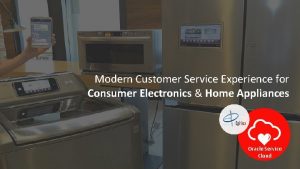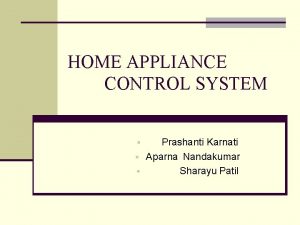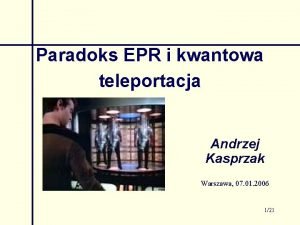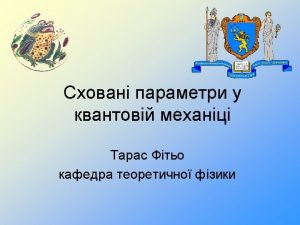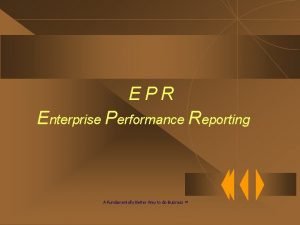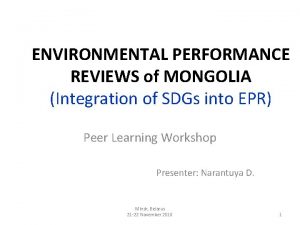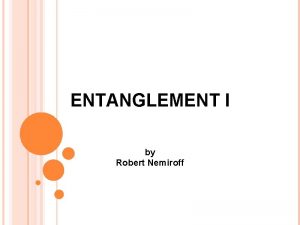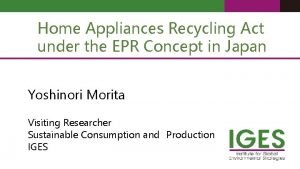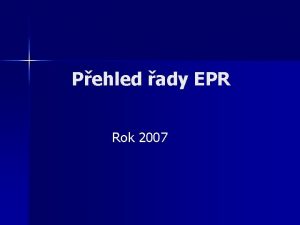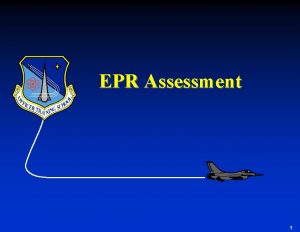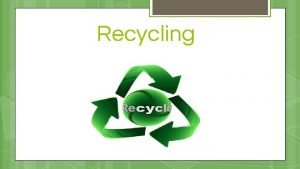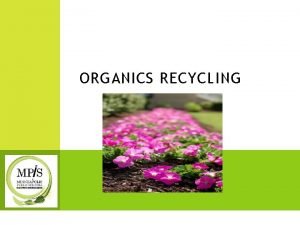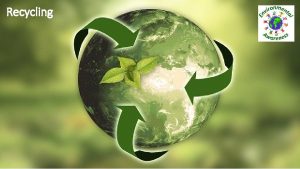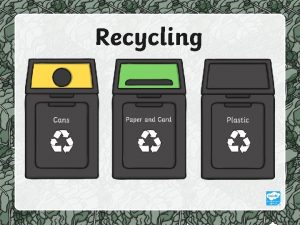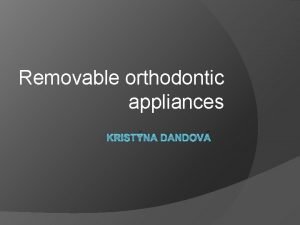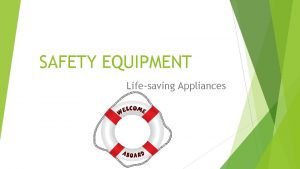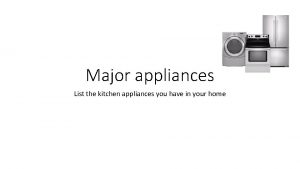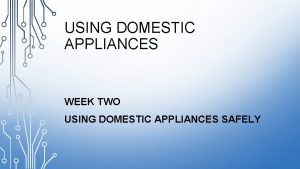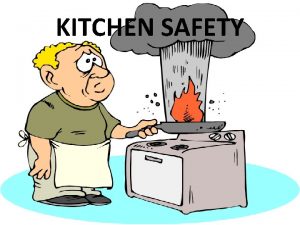Home Appliances Recycling Act under the EPR Concept















- Slides: 15

Home Appliances Recycling Act under the EPR Concept in Japan Yoshinori Morita Visiting Researcher Sustainable Consumption and Production IGES

Legislative Framework Fundamental Environmental Law (1993~) Fundamental Law for Establishing a Sound Material-Cycle Society (2000~) Waste Management and Public Cleansing Law (1970~) Law for Promotion of Effective Utilization of Resources (1991~) Regulation on individual items ü Home Appliances Recycling Law (2001~) (Air conditioners, Refrigerators, Washing machines, TV-Set) ü Small Home Appliances Recycling Law (2013~) (Small sized WEEE) ü ü Food Recycling Law (2000~) End-of-Life Vehicle Recycling Law (2005~) Containers and Packaging Recycling Law (1995~) Construction Material Recycling Law (2000~) 2

Background of Establishing “Home Appliances Recycling Law” Many of the local governments ( total number >1, 700) collected household appliances as incombustible garbage, and they were crushed and discarded in landfill. However, with the increasing amount of WEEE, the capacity of the landfills became smaller and the treatment cost became higher. The government newly fixed the Home Appliances Recycling Law in 2001. The Home Appliances Recycling Law was aimed only at four large-sized items (Refrigerator, Air conditioner, TV set, Washing machine) to conserve disposal space and resource utilization. Treatment responsibility shifted to the manufacturer (as EPR) from the local governments. The collecting point and the processing plant was improved all over the country. 3

Recycling etc. Customers ü Proper transfer ü Payment of the fees concerning collection and transport and recycling (Recycling fees (example of a major manufacturer) air-conditioner: 3, 150, television set: 1, 785~2, 835, refrigerator and freezer: 3, 780~ 4, 830, washing machine: 2, 520) Retailers ü Collect and transfer (1) Target equipment that the retailer sold in the past (2) Target equipment that is requested for collection when the product is replaced Manufactures ü Management of recycling system (1) Monitoring recycling plants operation (2) Technological development of recycling (waste reduction, resource efficiency) Municipalities Collection Transport Discharge EPR system under Home Appliance Recycling Law Association for Electric Home Appliances Recycling Plants There are 46 recycling plants Recycling level is required according to recycling standards 4

Recycling Plants Major producers are divided into two groups to fulfill EPRrequirements (Group A and B). Group A to use existing recyclers and Group B to establish new recycling facilities. 46 recycling plants (Group A : 28, Group B : 16, A・B common 2) Group A : Panasonic, Toshiba, Victor, LG Electronics Japan, etc. Group B : Sharp, Fujitsu, Hitachi, Sony, Mitsubishi, etc. 335 designated collection point (stock yard) Regular information exchange and interaction between recycling plant and manufacturers contribute to promote Design for Environment (Df. E) 5

Financial Balance of EPR System Recycling Fee(USD/Unit) Recycling Fee Recycling plants operation Collection Transfer FY Air conditioners 16 inch~ TV sets ~15 inch 171 L~ Refrigerators ~170 L Washing machines 2013 15. 75 28. 35 17. 85 48. 30 37. 80 24. 20 System management Expenditure 0 Source : Ministry of Economy, Trade and Industry 6

Financial Balance of Recycling Plant Commission Fee is reviewed annually Management O&M Sales of valuable resources 0 Waste Management (Dust) Profit Depend on resource prices Source : Ministry of Economy, Trade and Industry 7

Performance of the system Recycling rate for collected items ※Materials not recycled Mixed plastics metals not suitable for recycling, urethane foam, CRT glasses, waste oil, CFCs/HCFCs 8

Estimate of Material Flow of Used Home Appliances in Japan Approx. 50%: Official Route of Recycling Under the Act Approx. 20%: Domestic Reuse Market or Informal Scrap Material Market Approx. 30%: Export as Reuse Product or Eventually as Scrap for Recycling Purpose Source: MOE-METI joint panel. Report on the evaluation and review of the process in the implementation of the home appliance recycling system [in Japanese] , February 2008. http: //www. aeha. or. jp/recycling_report/pdf/kadennenji 24. pdf p. 61 9

Recycling Process (Refrigerator) CFCs/HCFCs Recovering CFCs/HCFCs Waste Treatment Plant (Incineration Plant) Manual Dismantling Separation Process Mechanical Shredding Hazardous substances (Heavy metal, Hg particle …) Dust, Plastics Valuable resources (Compressor, Printed circuit boards) Metals (Iron, Aluminum, Copper, etc. ) Smelting and Refining Plant Plastic Recycling 10

Smelting and Refining Process TSL furnace : Top Submerged Lance ü The furnace specific to recyclable materials ü Easily control temperature and furnace atmosphere ü Tolerance toward size and moisture of recyclable materials Pulverized Coal Oxygen Air Recyclable materials Lime Gas treatment Au Ag Cu Sn Bi Sb Gas Pb, Zn, Bi, Sb, etc. Elution Cu, Ni Slug Fe. Ox, Al 2 O 3, Si. O 2 Slug Metal Cu, Ag, Pd, Pt, etc. Residue Au, Ag, Pd, Pt Metal TSL furnace Dissolving tank 11

Customers ü Proper transfer ü No obligation to pay recycling fee Collection Transport Targeting on most of home appliances other than 4 categories covered by Home Appliances Recycling Law Municipalities ü Collect and transfer Recycling etc. Discharge Small Home Appliances Recycling Law Recyclers ü Adequate recycling (1)Municipalities can decide targeted categories and collection method (1)Recycler have to get a license from central government (2)They must receive products from municipality except for valid reasons 12

Multiple benefits Social benefit:Effect of waste reduction by turning bulky wastes into recyclables is estimated as 5. 4 billion/yen total cost reduction and benefit is generated compared to non-enforcement scenario. Source: reference materials for the 11 th meeting of the MOEMETI joint panel GHG Reduction:IGES has conducted life cycle assessment of recycling system and concluded that there is a significant GHG reduction effect through resource recovery compared to virgin material production. Source: IGES (2013) Policy research on environmental economics for FY 2012. 13

Conclusions Home Appliances Recycling p Reduction of waste generated from households. More than 50% of the total WEEE generation is estimated to be collected for recycling. p Increase of remaining capacity of landfill sites. p By classifying role and cost burden sharing among stakeholders, physical responsibility for WEEE management transferred from local government to product producers. p Recycling fee is gradually decreasing thanks to recycling technologies development and application of Df. E. n Some WEEE is being managed improperly. n Collection rate can be improved. Small Home Appliances Recycling p It covers wide varieties of WEEE, resulting increase of resources recycled. p Prevent WEEE from improper recycling and illegal exportation. n The law is not based on EPR thus physical responsibilities for WEEE management is unclear. n No stakeholders have a responsivities to pay recycling fee. Municipalities have to use city budget for collection and Recyclers cannot get financial supports for operation. It is difficult to cover operation cost by sales of collected resources except for cases of PC and mobile phone. 14

Thank you for your attention Yoshinori Morita morita@iges. or. jp 15

